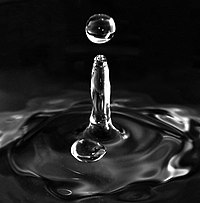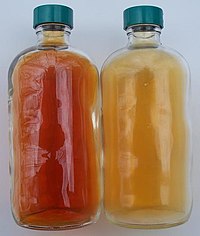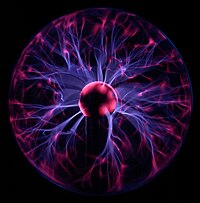Matter
From Wikipedia, the free encyclopedia
This article is about the concept in the physical sciences. For other uses, see Matter (disambiguation).
    | |
| Matter is usually classified into three classical states, with plasma sometimes added as a fourth state. From top to bottom: quartz (solid),water (liquid), nitrogen dioxide (gas), and aplasma globe (plasma). |
Before the 20th century, the term matter included ordinary matter composed of atoms and excluded other energy phenomena such as light or sound. This concept of matter may be generalized from atoms to include any objects having mass even when at rest, but this is ill-defined because an object's mass can arise from its (possibly massless) constituents' motion and interaction energies. Thus, matter does not have a universaldefinition, nor is it a fundamental concept in physics today. Matter is also used loosely as a general term for the substance that makes up all observable physical objects.[1][2]
All the objects from everyday life that we can bump into, touch or squeeze are composed of atoms. This atomic matter is in turn made up of interacting subatomic particles—usually a nucleus of protons and neutrons, and a cloud of orbiting electrons.[3][4] Typically, science considers these composite particles matter because they have both rest mass and volume. By contrast, massless particles, such as photons, are not considered matter, because they have neither rest mass nor volume. However, not all particles with rest mass have a classical volume, since fundamental particles such as quarks and leptons (sometimes equated with matter) are considered "point particles" with no effective size or volume. Nevertheless, quarks and leptons together make up "ordinary matter", and their interactions contribute to the effective volume of the composite particles that make up ordinary matter.
Matter commonly exists in four states (or phases): solid, liquid and gas, and plasma. However, advances in experimental techniques have revealed other previously theoretical phases, such as Bose–Einstein condensatesand fermionic condensates. A focus on an elementary-particle view of matter also leads to new phases of matter, such as the quark–gluon plasma.[5] For much of the history of the natural sciences people have contemplated the exact nature of matter. The idea that matter was built of discrete building blocks, the so-called particulate theory of matter, was first put forward by the Greek philosophers Leucippus (~490 BC) andDemocritus (~470–380 BC).[6]
Matter should not be confused with mass, as the two are not quite the same in modern physics.[7] For example, mass is a conserved quantity, which means that its value is unchanging through time, within closed systems. However, matter is not conserved in such systems, although this is not obvious in ordinary conditions on Earth, where matter is approximately conserved. Still, special relativity shows that matter may disappear by conversion into energy, even inside closed systems, and it can also be created from energy, within such systems. However, because mass (like energy) can neither be created nor destroyed, the quantity of mass and the quantity of energy remain the same during a transformation of matter (which represents a certain amount of energy) into non-material (i.e., non-matter) energy. This is also true in the reverse transformation of energy into matter.
Different fields of science use the term matter in different, and sometimes incompatible, ways. Some of these ways are based on loose historical meanings, from a time when there was no reason to distinguish mass and matter. As such, there is no single universally agreed scientific meaning of the word "matter". Scientifically, the term "mass" is well-defined, but "matter" is not. Sometimes in the field of physics "matter" is simply equated with particles that exhibit rest mass (i.e., that cannot travel at the speed of light), such as quarks and leptons. However, in both physics and chemistry, matter exhibits both wave-like and particle-like properties, the so-called wave–particle duality.[8][9][10]



ليست هناك تعليقات:
إرسال تعليق